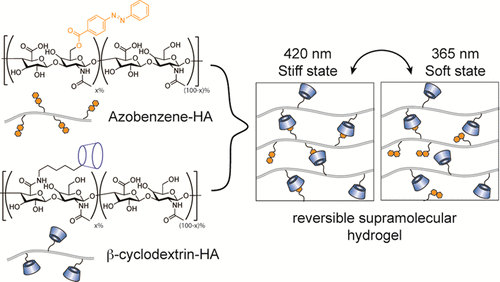当前位置:
X-MOL 学术
›
Bioconjugate Chem.
›
论文详情
Our official English website, www.x-mol.net, welcomes your feedback! (Note: you will need to create a separate account there.)
Reversible Control of Network Properties in Azobenzene-Containing Hyaluronic Acid-Based Hydrogels.
Bioconjugate Chemistry ( IF 4.7 ) Pub Date : 2018-02-19 , DOI: 10.1021/acs.bioconjchem.7b00802 Adrianne M Rosales 1 , Christopher B Rodell 2 , Minna H Chen 2 , Matthew G Morrow 2 , Kristi S Anseth 1 , Jason A Burdick 2
Bioconjugate Chemistry ( IF 4.7 ) Pub Date : 2018-02-19 , DOI: 10.1021/acs.bioconjchem.7b00802 Adrianne M Rosales 1 , Christopher B Rodell 2 , Minna H Chen 2 , Matthew G Morrow 2 , Kristi S Anseth 1 , Jason A Burdick 2
Affiliation

|
Biomimetic hydrogels fabricated from biologically derived polymers, such as hyaluronic acid (HA), are useful for numerous biomedical applications. Due to the dynamic nature of biological processes, it is of great interest to synthesize hydrogels with dynamically tunable network properties where various functions (e.g., cargo delivery, mechanical signaling) can be changed over time. Among the various stimuli developed to control hydrogel properties, light stands out for its exquisite spatiotemporal control; however, most light-based chemistries are unidirectional in their ability to manipulate network changes. Here, we report a strategy to reversibly modulate HA hydrogel properties with light, using supramolecular cross-links formed via azobenzene bound to β-cyclodextrin. Upon isomerization with 365 nm or 400-500 nm light, the binding affinity between azobenzene and β-cyclodextrin changed and altered the network connectivity. The hydrogel mechanical properties depended on both the azobenzene modification and isomeric state (lower for cis state), with up to a 60% change in storage modulus with light exposure. Furthermore, the release of a fluorescently labeled protein was accelerated with light exposure under conditions that were cytocompatible to encapsulated cells. These results indicate that the developed hydrogels may be suitable for applications in which temporal regulation of material properties is important, such as drug delivery or mechanobiology studies.
中文翻译:

含偶氮透明质酸的水凝胶中网络性质的可逆控制。
由生物衍生的聚合物例如透明质酸(HA)制成的仿生水凝胶可用于许多生物医学应用。由于生物过程的动态性质,合成具有动态可调网络特性的水凝胶非常令人关注,其中各种功能(例如,货物输送,机械信号传递)可以随时间变化。在控制水凝胶特性的各种刺激中,光以其精巧的时空控制而引人注目。但是,大多数基于光的化学物质在控制网络变化方面具有单向性。在这里,我们报告了一种策略,该策略使用通过结合至β-环糊精的偶氮苯形成的超分子交联,用光可逆地调节HA水凝胶的特性。在365 nm或400-500 nm的光下异构化后,偶氮苯与β-环糊精之间的结合亲和力改变并改变了网络连通性。水凝胶的机械性能取决于偶氮苯的改性和同分异构状态(顺式较低),在曝光时储能模量最多可发生60%的变化。此外,在与包囊细胞具有细胞相容性的条件下,通过曝光加速了荧光标记蛋白的释放。这些结果表明,开发的水凝胶可能适用于对材料特性进行时间调节很重要的应用,例如药物输送或力学生物学研究。曝光时储能模量最多可发生60%的变化。此外,在与包囊细胞具有细胞相容性的条件下,通过曝光加速了荧光标记蛋白的释放。这些结果表明,开发的水凝胶可能适用于对材料特性进行时间调节很重要的应用,例如药物输送或力学生物学研究。曝光时储能模量最多可发生60%的变化。此外,在与包囊细胞具有细胞相容性的条件下,通过曝光加速了荧光标记蛋白的释放。这些结果表明,开发的水凝胶可能适用于对材料特性进行时间调节很重要的应用,例如药物输送或力学生物学研究。
更新日期:2018-02-06
中文翻译:

含偶氮透明质酸的水凝胶中网络性质的可逆控制。
由生物衍生的聚合物例如透明质酸(HA)制成的仿生水凝胶可用于许多生物医学应用。由于生物过程的动态性质,合成具有动态可调网络特性的水凝胶非常令人关注,其中各种功能(例如,货物输送,机械信号传递)可以随时间变化。在控制水凝胶特性的各种刺激中,光以其精巧的时空控制而引人注目。但是,大多数基于光的化学物质在控制网络变化方面具有单向性。在这里,我们报告了一种策略,该策略使用通过结合至β-环糊精的偶氮苯形成的超分子交联,用光可逆地调节HA水凝胶的特性。在365 nm或400-500 nm的光下异构化后,偶氮苯与β-环糊精之间的结合亲和力改变并改变了网络连通性。水凝胶的机械性能取决于偶氮苯的改性和同分异构状态(顺式较低),在曝光时储能模量最多可发生60%的变化。此外,在与包囊细胞具有细胞相容性的条件下,通过曝光加速了荧光标记蛋白的释放。这些结果表明,开发的水凝胶可能适用于对材料特性进行时间调节很重要的应用,例如药物输送或力学生物学研究。曝光时储能模量最多可发生60%的变化。此外,在与包囊细胞具有细胞相容性的条件下,通过曝光加速了荧光标记蛋白的释放。这些结果表明,开发的水凝胶可能适用于对材料特性进行时间调节很重要的应用,例如药物输送或力学生物学研究。曝光时储能模量最多可发生60%的变化。此外,在与包囊细胞具有细胞相容性的条件下,通过曝光加速了荧光标记蛋白的释放。这些结果表明,开发的水凝胶可能适用于对材料特性进行时间调节很重要的应用,例如药物输送或力学生物学研究。



























 京公网安备 11010802027423号
京公网安备 11010802027423号